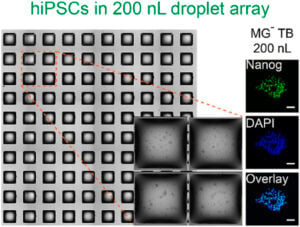The use of human induced pluripotent stem cells (hiPSCs) is indispensable for many biological research topics, such as disease modeling, toxicity assays, regenerative medicine and drug discovery. The work with hiPSCs is challenging, due to their poor proliferation rates and the inability to adhere to a Matrigel-free surface, therefore it is of high interest to develop methods to culture hiPSCs easily.
The authors have demonstrated a method to cultivate the cells in small 200 nl droplets on a Droplet Microarray chip (DMA). Using the I.DOT, they were able to dispense the delicate cells onto the DMA. This leads to an overall reduction of compounds, reagents and the valuable hiPSCs up to 10,000-fold.

Even more fascinating is the fact that this impressive work shows:
1) The hiPSCs can adhere to the Matrigel-free surface of the DMA,
2) The hiPSCs do not spontaneously differentiate on the Matrigel-free DMA and
3) Shows high expression of the pluripotency marker NANOG.
Great work by Yanxi Liu and Pavel Levkin. This is changing the way high-throughput screening can be administered to address many biological questions.
Link to the publication: